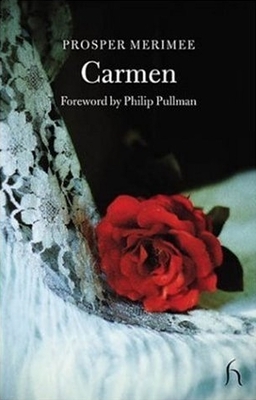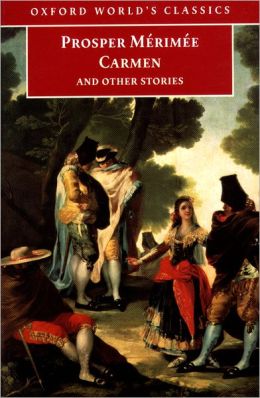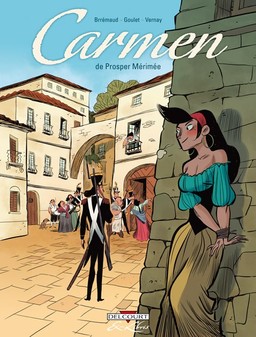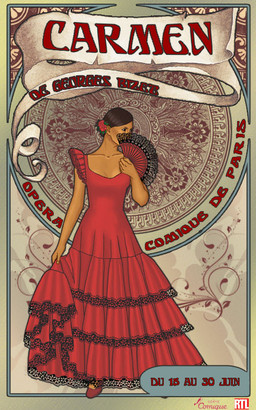Low Adventure: Clasp-knives and Fortunetelling in Carmen
 Why does it have to be the days of “high adventure?”
Why does it have to be the days of “high adventure?”
Low adventure can be extraordinarily riveting, as I recently found when I revisited Prosper Mérimée’s Carmen, the novella that inspired the Bizet opera. I’d read it once before, after seeing the (definitive, to my taste) Rosi film of the opera in the early 80s. Thanks to that film, I was so enchanted with the light and color of Andalusia that on my first trip to Europe I spent the better part of it there, on the coasts, in the alleys of Gibraltar, and especially in the stony mountains of Spain’s Sierra Nevadas. Thanks to a stay at an Andalusian cortijo (estate-farm) I was able to see some of the more remote areas on horseback, dragging a dutiful, saddlesore (need I say “ex”?) girlfriend behind who would have much rather been sunning on the beaches of Marbella or examining the wonders of the Alhambra.
Spain is a country of regions. The differences you might notice between northern Italians and southern are trebled in the expanses of Spain, divided as it is by mountains and joined by indirect routes reaching back into the dust of antiquity. There’s something of Robert E. Howard’s Zamora in Andalusia. Rome, the Caliphate, Catholicism, and for the history-minded traveller with a good guidebook, traces of the Phoenicians, Carthaginians, and Napoleon can still be found. Each province has its flavor, industrious Bilbao, pretentiously bustling Madrid, historic Toledo, artistic Barcelona, leaving a distinct impression. The Andalusians are famous for just living life. Every meeting is an excuse for a party, every parting as one between old friends. Visiting Spain revised my personal definitions of “courtesy” and “hospitality.”
I see I’ve imitated Mérimée in framing these notes, elaborating the circumstances of my acquaintance with Carmen and Don Jose and the search into their origins. So enough about me.
Carmen is not an epic tale of battles and thrones won and lost, though it is as filled with sex, doom, and bloody incident as Macbeth, more explicit than I would have believed possible for a novella published in 1845. Either Mérimée was the Tarantino of his day or the literature of the time was a good deal more lively than we suspect. It’s certainly juicier than Hugo.
 The novella opens with a suspenseful scene where the author, a scholar researching the true location of Munda, Julius Caesar’s last battle in his battle against the remnants of the Republic, comes across an armed bandit hiding in the hills. Though his Spanish guide is terrified, in a suspenseful scene the author puts on a show of bravado, ignoring the blunderbuss-armed bandit after a friendly nod and drinking deep from a pool. He then extracts his cigars and asks the bandit for a light, as one gentleman to another. The bandit obliges. In return, the courtesy continues as he offers the bandit his best cigar, and some meat meant to serve as friendly gesture.
The novella opens with a suspenseful scene where the author, a scholar researching the true location of Munda, Julius Caesar’s last battle in his battle against the remnants of the Republic, comes across an armed bandit hiding in the hills. Though his Spanish guide is terrified, in a suspenseful scene the author puts on a show of bravado, ignoring the blunderbuss-armed bandit after a friendly nod and drinking deep from a pool. He then extracts his cigars and asks the bandit for a light, as one gentleman to another. The bandit obliges. In return, the courtesy continues as he offers the bandit his best cigar, and some meat meant to serve as friendly gesture.
The cigar and meal cements something between the two, scholar and desperado, and a comity is established that will last through the rest of the novella. The bandit, who his guide identifies as “Jose Navarro,” accompanies the narrator for the rest of the day’s ride, and they stay at an appalling inn that even Hugo’s Thénardiers would find crude. There, the guide muffles his horse’s hooves and rides off to get the militia, for Navarro has a fortune of a price on his head and the guide means to have it. The scholar does his best to resolve a situation that leaves both his new friendship and respect for law and order intact.
In the next part of the novella, the author is doing some research in a monestary’s archives. While exploring the city after the heat of the day, he encounters a woman who identifies herself as “La Carmencita.”
I can’t help but quote the author in full in describing her:
I seriously doubt whether Señorita Carmen was of the pure breed; at all events, she was infinitely prettier than any of the women of her nation whom I had ever met. No woman is beautiful, say the Spaniards, unless she combines thirty so’s; or, if you prefer, unless she may be described by ten adjectives, each of which is applicable to three parts of her person. For instance, she must have three black things: eyes, lashes, and eyebrows, etc. (See Brantôme for the rest.) My gypsy could make no pretension to so many perfections. Her skin, albeit perfectly smooth, closely resembled the hue of copper. Her eyes were oblique, but of a beautiful shape; her lips a little heavy but well formed, and disclosed two rows of teeth whiter than almonds without their skins. Her hair, which was possibly a bit coarse, was black with a blue reflection, like a crow’s wing, and long and glossy. To avoid fatiguing you with a too verbose description, I will say that for each defect she had some good point, which stood out the more boldly perhaps by the very contrast. It was a strange, wild type of beauty, a face which took one by surprise at first, but which one could not forget. Her eyes, especially, had an expression at once voluptuous and fierce, which I had never seen in any mortal eye. “A gypsy’s eye is a wolf’s eye” is a Spanish saying which denotes keen observation. If you have not the time to go to the Jardin des Plantes to study the glance of a wolf, observe your cat when it is watching a sparrow.
Soon after meeting the narrator, she admits to sorcery and dealings with the Devil. The writer, who admits to dabbling in it himself in his school days, in intrigued and wishes to see her practice her art.
 Our “sorceress” takes him back to her lair, promising to read his fortune. In reality, she’s clearly after his fine gold watch. There, in the middle of his fortune-reading, he encounters Don Jose a second time when the bandit enters. Don Jose immediately renews their friendship and sees to it that our narrator escapes that dangerous corner of the city with his life (to Carmen’s evident disappointment), but not his watch, which was picked out of his pocket.
Our “sorceress” takes him back to her lair, promising to read his fortune. In reality, she’s clearly after his fine gold watch. There, in the middle of his fortune-reading, he encounters Don Jose a second time when the bandit enters. Don Jose immediately renews their friendship and sees to it that our narrator escapes that dangerous corner of the city with his life (to Carmen’s evident disappointment), but not his watch, which was picked out of his pocket.
Disenchanted with the city and his night with Carmen, the narrator leaves town and resumes his field archeology.
Returning to the monastery some weeks later, the monks are thrilled to see him alive. His watch has been recovered during the capture of the notorious bandit Jose Navarro. They believed him murdered. The monks arrange an interview in the prison.
The bulk of the novella is the third part, the prison interview, as Don Jose tells the story of his downfall to our author. Much of it will be familiar to fans of the opera, with the fracas at the cigar factory and Carmen convincing the lonely young corporal to let her escape before they reunite after his demotion and spell in the guardhouse. But there are several meaty tales after Don Jose deserts that are disposed of or condensed by Bizet, elaborating on his downward spiral that turns into a death-dance with Carmen. From the duel with his lieutenant on, sin plucks on sin, as Shakespeare’s Richard noticed. Don Jose and Carmen join a small band of smugglers, mostly bringing English goods in from Gibraltar, but when desperate or when opportunity presents itself, they turn to robbery. He descends from smuggling to robbery to outright murder, egged on by his lover. There’s little honor among thieves, and the two best scenes are a running gunfight with the military where the band’s dreadful leader kills a wounded comrade by discharging a blunderbuss into his follower’s face, and a knife fight between Don Jose and Carmen’s husband, the same leader who killed one of his followers and then settled down to a game of cards. These incidents, the “business of Egypt” as Carmen phrases it, are quite well-told and would stand up well against any of the authors more frequently discussed here at Black Gate.
Meanwhile, Carmen grows increasingly distant and fatalistic, for her fortune-telling keeps revealing that she must die, then Don Jose shortly after.
What did I take away from this masterly tale (beyond the pleasure of reading it) that might apply to my own writing? It’s a fine example of how to handle provincialism. We live in a world where the current weather and top stories in the Crimea or Chile are but a click or two away. It’s easy to forget what it’s like to be a stranger in a strange land in our world where you can be both everywhere and nowhere, thanks to the Internet. I can find out how my mother is doing by picking up the phone or checking Facebook. Don Jose, as an exile (he owes his army enlistment to a knife fight after a tennis match in his youth), is urged into throwing away his rank over something as minor as a few words in his home tongue, albeit atrociously pronounced. The novella does a great job of handling tribalism, whether its that of the gypsy smugglers, the military, the women at the cigar factory where Carmen works, or the church and aristocracy. The fact that Merimee handles it so adroitly with a few lines in a paragraph proves him a first-class writer.
Second, the fights and escapades, in their small-scale grit and sweat, convey an authenticity that impresses. When you have a man whipping off his hat to use it as a shield in a fight involving folding knives, the stakes of a bandit’s campfire seem every bit as great as a clash of empires. Carmen’s alley escape is equally well handled:
I doubted whether that girl ever said a true word in her life; but when she spoke, I believed her; it was too much for me. She murdered the Basque language, yet I believed that she was a Navarrese. Her eyes alone, to say nothing of her mouth and her colour, proclaimed her a gypsy. I was mad, I paid no heed to anything. I though that if Spaniards had dared to speak slightly to me of the provinces, I would have slashed their faces as she had slashed her comrade’s. In short, I was like a drunken man; I began to say foolish things, I was on the verge of doing them.
“‘If I should push you and you should fall, my countryman,’ she continued in Basque, ‘it would take more than these two Castilian recruits to hold me.’
“‘Well, my dear, my countrywoman, try it, and may Our Lady of the Mountain be with you!’
“At that moment we were passing one of the narrow lanes of which there are so many in Seville. All of a sudden Carmen turned and struck me with her fist in the breast. I purposely fell backward. With one spring she leaped over me and began to run, showing us a fleet pair of legs! Basque legs are famous; hers were quite equal to them-as swift and as well moulded. I sprang up instantly; but I held my lance horizontally so as to block the street, so that my men were delayed for a moment when they attempted to pursue her. Then I began to run myself, and they were at my heels. But overtake her! there was no danger of that, with our spurs, and sabres, and lances! In less than it takes to tell it, the prisoner disappeared. Indeed, all the women in the quarter favoured her flight, laughed at us, and sent us in the wrong direction. After marching and countermarching, we were obliged to return to the guard-house without a receipt from the governor of the prison.
 Even if 1830s Spain, it’s all about the paperwork!
Even if 1830s Spain, it’s all about the paperwork!
Third, sorcery can and should be utterly mundane, at least occasionally. In Carmen, beyond the frequent fortune-telling, there’s a good deal of talk of love charms and “when will I see him again” devices resorted to by desperate young lovers that Romani and their ilk are only too happy to use in fleecing the gentiles. Take inspiration from daytime television advertising. We can make our own sorcerers a little more believable by having them continually sought for help (or desperate enough to earn some coin), intervening with love lives, anti-aging remedies, help with finances and profitable employment, seeking installation of or relief from pregnancy, and other everyday crises.
Fourth, the yarn is told with economy. Mérimée manages to cram a great deal of flavor into a few words, especially when describing the busy, narrow streets of the cities and the dusty, lonely roads of the hills and mountains. So on the rare occasions he resorts to a paragraph of description, it has all the more significance.
And last, Carmen is a supreme example of an independent woman in a period, patriarchal society (including that of the Romani, who don’t let their women engage in outright prostitution and frown on a woman taking lovers). Though there’s no nonsense about her being a match for a skilled man in a knife fight, she’s worth any three men of the smuggling band for her brains, audacity, and skill. Even Don Jose in his jail cell, though he frequently calls her “a devil,” grants her that. Sex is both a tool and a pleasure in its own right for her. While she’s not a hostage to her loins, they do betray when she returns to Don Jose multiple times when she might be rid of him. Her sexuality, to my mind, is more of a symbol of the freedom she holds so dear. I would rank Carmen with Mitchell’s resourceful Scarlett O’Hara or Austen’s uncompromising Elizabeth Bennet as one of the most memorable women of literature.
You can read the story for free here.
If you are a fan of the opera and haven’t yet seen the 1984 Rosi film, starring Julia Migenes as Carmen, I can’t recommend it highly enough. It is available, for now, on Amazon.
For a filmed version of the novella rather than the more famous opera, Vicente Aranda made a 2003 movie starring Paz Vega. It takes a few liberties with the story (fewer than Bizet, however), but keeps the author’s framing and narrative intact.
Wow — I would never have thought I wanted to read it until I read your essay. Now I’m giving it a place in the TBR pile that’s not too far down the stack.
Also, that was a fab write-up. Nicely done, man.
It’s an easy read. I think I finished it in something like an hour. Perfect for a quiet session before bed.